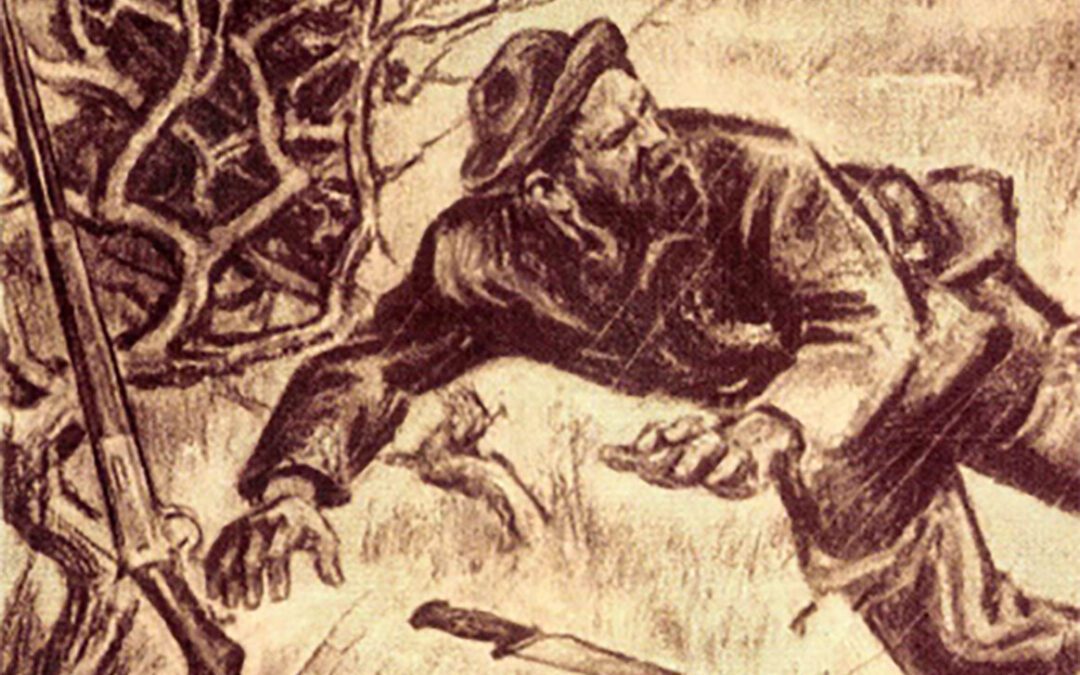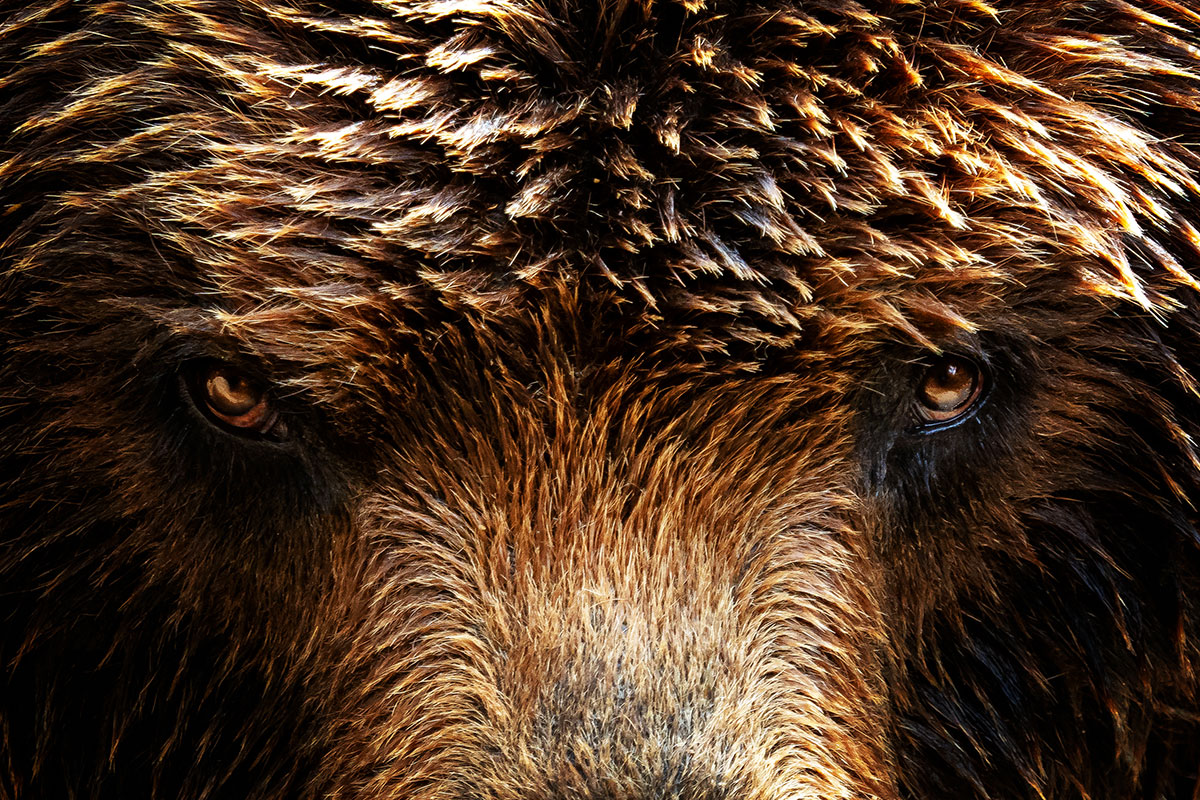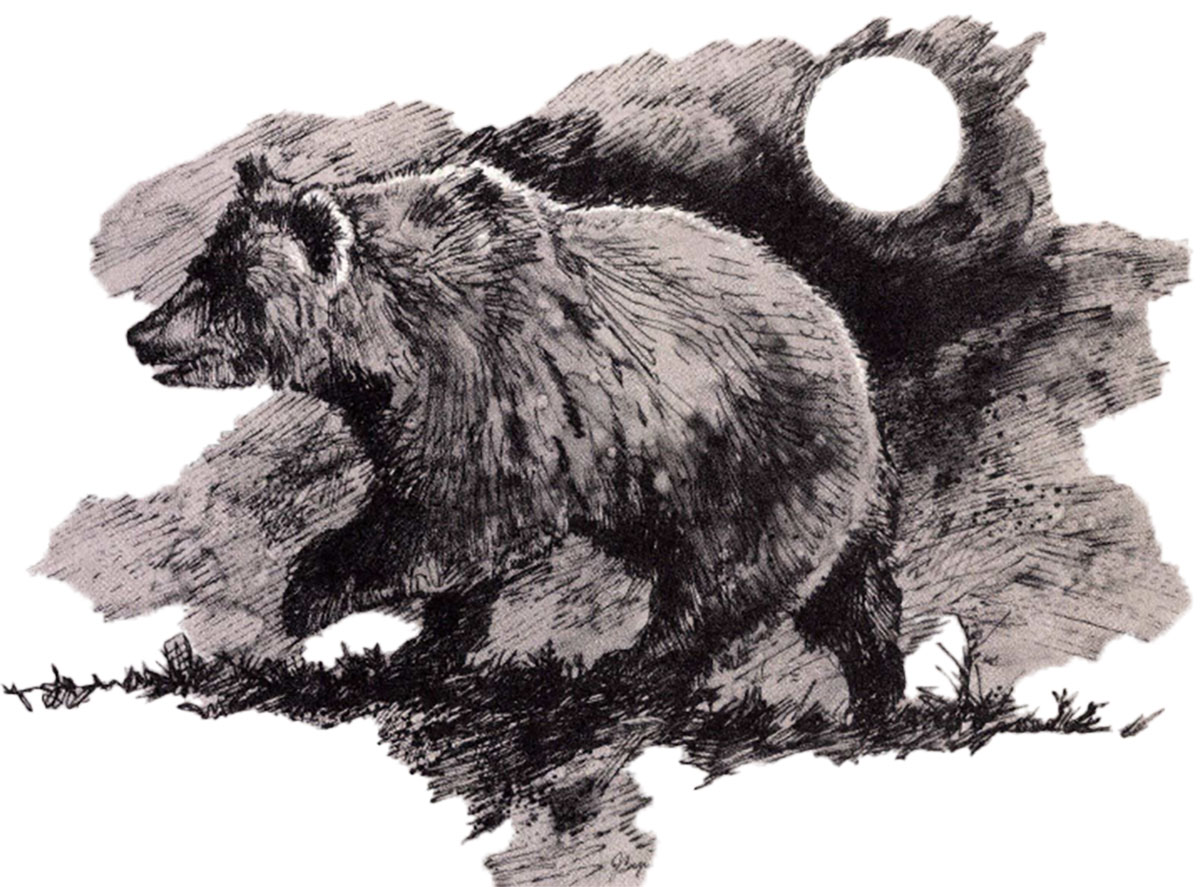Frank C. Hibben once wrote that Allen Hasselborg was, “… the one human being who has come the closest to knowing all there is to know about bears.”
Allen Hasselborg was a very tall man, full-bearded, with large, capable hands. When Frank Hibben first saw him, standing on the shore of Admiralty Island, he remarked that Hasselborg looked “like a prophet in hip waders.”
By that time, the late 1930s, Hasselborg’s beard and shaggy hair were fully gray, for he was then 60 years old. But that is how Hibben saw him first and remembered him always: A solitary bearded man in hip boots, holding a rifle, standing in the rain.
More than 10 years after their first meeting, Frank C. Hibben — college professor, writer, hunter and future Weatherby Trophy winner — wrote a book called Hunting American Bears. It is dedicated to Allen Hasselborg, “… the one human being who has come the closest to knowing all there is to know about bears.”
Hasselborg may well have known more about Alaska brown bears than anyone else, and he acquired that knowledge in the hardest way imaginable. No one on earth could have blamed him had he come away from his encounter in 1918 hating and fearing the big bears of the Pacific Coast Islands.
Exactly why he crawled back from death, then decided not to kill more bears but to live among them, and learn about them, no one, now, can ever know. The closest we can come to understanding Hasselborg is in the pages of the two chapters of Hibben’s book devoted to the old man; those two chapters, and a footnote here and there in other mens’ books, and scanty personal recollections that grow scantier by the year.
We know that Allen Hasselborg was born in Minnesota in 1876, and made his way west as a mule skinner. In 1898, he joined the stream of men leaving Seattle for the Klondike, but did so with a different purpose: Rather than pan for gold, he went to hunt Alaska brown bears for their hides.
Hasselborg disembarked at Ketchikan, where he built himself a sailing skiff to carry him to Chichagof, Baran of Admiralty, and the smaller rain-soaked, fern-choked islands that clog the inner passage.
A natural hunter, he adapted quickly to the ways of coastal Alaska and soon established a reputation. In 1908, the University of California sent the Alexander Alaska Expedition north to study the birds and mammals of Prince William Sound. The leader, Annie M. Alexander, hired Allen Hasselborg to do the necessary hunting, and it is on record that he killed, among other things, the specimen bears of Montague Island that helped confirm the subspecies Ursus arctos sheldoni, named for Charles Sheldon. This accomplishment is mentioned in Sheldon’s own book, The Wilderness of the North Pacific Coast Islands (later reprinted by Amwell Press).
Bob De Armond, a retired newspaperman and historical writer who grew up on the coast, says brown bearskins brought barely $15 apiece in those days. Still, Hasselborg kept at it, hunting the islands, bringing the skins into Ketchikan, and occasionally coming to Juneau in his small boat to pick up supplies.
The ordeal that altered everything occurred around 1918 — the dates are vague — when he landed his skiff in Basket Bay, on the coast of Chichagof Island. He was, as always, alone. He carefully drifted the skiff out beyond the low tide mark and dropped the heavy anchor to hold it. This is still standard procedure for bear guides, as is the means of doing it: the long rope, the slip knot, the coiled anchor chain. With his boat floating and safely secured, Hasselborg checked his Winchester and his belt knife, then set off inland.
These islands are all similar — a spine of mountains, with their slopes smothered in rainforest, and rivers spilling down to a coastal plain before draining into the ocean. The flats are choked with alders and high grass, and crisscrossed with bear trails. Salmon swim the rivers and bears come down to catch them. So, when you head inland, you watch for bears from the moment you leave the beach. Or sooner, for that matter.
Hasselborg was only a few hundred yards in when he found a bear track more than a foot-and-a-half long, the mark of a monster whose size could barely be imagined. Continuing on to a small lake, he spotted a brown mound on the far side, and a deer skipped away nervously. The mound was a bear, to be sure — a small one? No! The mound that looked like a small bear was, in reality, just the hump of a truly huge bear showing above the grass! Hasselborg froze, and began to figure out how he could get within shooting distance.
Carefully, freezing motionless whenever the bear raised its head, he worked his way around the swamp, and then into the water near a beaver dam. He was in up to his waist, moving slowly, slowly; the bear would raise his head, Hasselborg would freeze, then he would resume eating. The bear was alert, but Hasselborg was experienced. He inched forward. Then an alder branch buried in the mud sprang loose and showered water and gravel. The bear rose, alarmed and angry, and came at a run. At 15 yards, mired in water and mud, Hasselborg could do nothing but center the sights on him and fire. The bear stopped, blowing blood, then crumpled in a heap.
Allen Hasselborg was then in his 40s and had been hunting bears for half his life. He killed many, but he still loved the chase and was excited. He struggled to shore, his experience and caution overwhelmed by the sight of a bear with a head like a washtub, a bear that might square 16 feet, a bear that could weigh upwards of a ton, an Alaska brown bear with a record skin that would certainly bring twice the normal price in Ketchikan.
The bear was a huge mound of fur, motionless in the meadow, when Allen Hasselborg sloshed up, leaned his rifle against a bush, drew his knife, and turned back to find himself facing a black wet wall that blotted out the sky. Baffled, he looked up …
“His mouth sagged open in his beard and his eyes went glassy at what he saw. There was a splotch of red on top of the thing, and black, too, and white dripping in between. It was the jaws of a monster bear — a towering hulk of a thing that stood over him like the impending doom that it was.”
Frank Hibben’s account of Hasselborg’s encounter with the monster bear of Chichagof Island, “One Bite is Enough,” is one of the two finest bear-hunting stories ever written — the other being his own journey with Hasselborg into the interior of Admiralty Island, “Hasselborg’s Hangout.” Both were chapters in Hunting American Bears, and both were reprinted many years later in the Amwell Press anthology, Hunting the North Country. Like Hasselborg himself, both deserve to be better known than they are. But back to Chichagof Island …
“The bloodshot eyes of the apparition glared down at him from a height twice his own (and Hasselborg was a tall man!). He saw but vaguely the bloody foam dripping from those awful jaws ….”
Allen Hasselborg had forgotten his own rule about approaching dead bears, and now he was about to learn one more lesson — the final one.
His rifle, two steps behind him, might as well have been in Seattle. The knife in his hand – useless! The bear ground his teeth and raised a paw whose six-inch claws hung close by Hasselborg’s face. Running — pointless! The bear swayed, dead, it seemed, on his feet. In one last desperate measure, Hasselborg turned and leapt, diving for the earth to burrow in, face down, seeking refuge in the mud and grass, praying that he could last through the damage the bear might do to him in his own final few seconds of life.
The first swipe of the gigantic paw swept away Hasselborg’s belt and most of his clothing. He hugged his arms tighter around his head. The second swipe dug into his flesh as the bear tried to turn him over. He felt the bear’s breath on his back, and smelled the rotting salmon, and heard the growl as the jaws spread wide, and felt the teeth sink into his shoulder. Hasselborg dug his fingers deeper into the mud and prayed now, not for salvation, but only for unconsciousness.
But when it came, he felt it. He felt all of it.
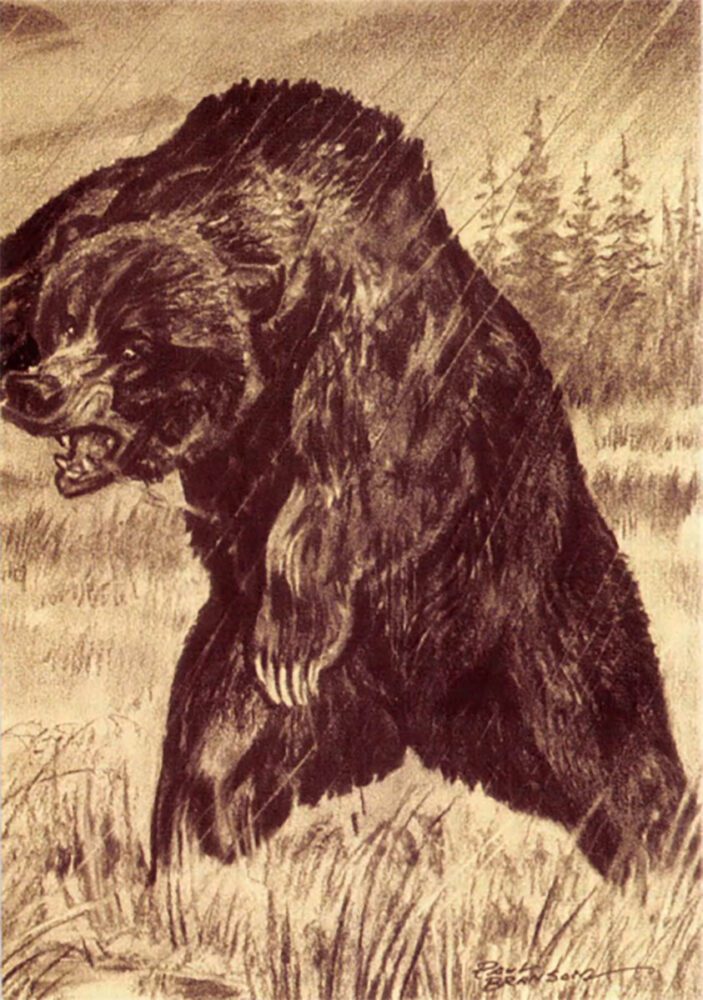 “He felt the bear’s teeth slide along the bone and the huge muzzle turned sideways to get a better purchase on the roundness of his shoulder. He heard the noise of his muscles being torn from the shoulder blade. ‘God — God —’ he cried in his agony through the mud in his mouth. It was over. This must be death….”
“He felt the bear’s teeth slide along the bone and the huge muzzle turned sideways to get a better purchase on the roundness of his shoulder. He heard the noise of his muscles being torn from the shoulder blade. ‘God — God —’ he cried in his agony through the mud in his mouth. It was over. This must be death….”
A curious thing about Allen Hasselborg, later in life, is that he was not known as a bear hunter, but as a bear naturalist — a man who lived among them, surrounded by them on Admiralty Island, who studied them, and who never attacked them. Nor they him.
“He was really known as a naturalist,” Bob De Armond now recalls. “His early reputation, as a bear hunter . . .we never thought of him that way.”
Hasselborg’s career as a bear hunter ended that day on Chichagof Island. Harrowing as the account of the attack is, the story of how he saved himself is even more so.
He awoke in darkness, face down in mud, naked in a steady rain, with blood clotted in the grass around “like clumps of raw liver.” His left arm hung white, withered and useless, the shoulder muscle torn completely away. Hasselborg had no idea whether it was the evening of the same day or dawn of the next. His rifle lay next to him, the stock bitten off, the magazine crushed. The bear — thank God’ — was nowhere to be seen. Weak with loss of blood, in unspeakable agony from his destroyed shoulder, using the broken rifle as a crutch, Hasselborg struggled back to his boat, more than a mile along the trail, one excruciating step at a time. More than once he passed out and it was dark by the time he made it down, finally reaching the beach on his knees and his one good hand.
There, he passed out once again and slept until dawn in the steady rain.
With dawn came low tide. He managed with one hand to untie the rope, then waded out to the boat. The water came to his chest by the time here ached it, and there was no way he could pull himself over the gunwale. Dizzy and losing consciousness, he struggled back to shore in defeat. Then it struck him that he might pull the boat into shallower water. He pulled on the land line, and the boat came in until the anchor halted it. Still, the water was shallower – only waist deep now, and Hasselborg heaved himself over the side and fell lifeless into the bottom of the boat.
Each time he thought he had reached safety, however, he encountered a new obstacle, each one more difficult to surmount in his increasing weakness.
Now it was the anchor chain. With only one arm, weak from exhaustion and loss of blood, and more than a day without food, there was no way he could lift the heavy anchor from the ocean floor, and the chain was made of steel. This, it appeared, was the end. The strain of pulling on the chain ruptured his shoulder, which began to bleed into the blanket he had wrapped himself in. In the small cabin he passed out once again, this time from despair as much as anything, and slept through the night.
The next day he tried to make some soup, but could not master the burner on his oil stove. The blanket stuck to him in a mass of dried blood, his cheeks were sunken, and his hair was matted. In the afternoon, he tried again to raise the anchor. Nothing. That night he forced down some cold soup. His shoulder had stopped hurting now, and that was not a good sign. He did not want to die of gangrene.
The morning of the third day, Hasselborg was close to the end. A prisoner of his own anchor chain, unable to rise from the deck, his mind cleared for a moment and he forced himself to make one last effort.
“He felt beyond the need of load, now, and his fevered eyes swung idly around this boat that he had built himself It was the glance of a dying man that surveys his possessions for the last time ….”
One possession he saw was his woodsman’s axe, rusting in the rain, but still razor sharp. Could that axe …?
Hasselborg struggled to his feet, pulled the axe from the wall, and dragged it and his body forward. He crawled out on the deck, raised himself to his knees, and summoned all his strength for one blow. Just one, last …!
“That evening a small boat drifted out of Basket Bay on the ebbing tide. On the decked-over fore part of this craft there was a crumpled figure wrapped in a gray blanket with a large spot of crusted blood on one side. It was in the half light of the next dawn when a small skiff with a half of a sail came into the harbor of the Indian village of Hoonah.
“I haven’t killed a bear in 20 years,” Hasselborg told Hibben when they first met. He said it with a slight smile of recollection. But he did guide Hibben, and Hibben did shoot one, and they became friends.
By that time, Hasselborg was living alone in a log cabin on Admiralty Island, beside Pack Creek, in a natural landing called Mole Harbor. Hibben could sail his own boat into the harbor and anchor it there, and go ashore to visit with his new acquaintance.
What he found was a man of fixed habits, and no neighbors save the brown bears that fished for salmon in the creek. Hasselborg raised vegetables, smoked salmon, killed the occasional deer. It was a hundred miles to Juneau, and his only transportation was his rowboat. A couple of times a year, he would go across for supplies and take out a new batch of books from the Juneau Library. Hasselborg was a well-read man of firm opinions, as Hibben found out to his cost when once he tried to eat his stew sitting on the bed. It was a one-room cabin, but there was the corner for dining, and there was the corner for sleeping.
Hasselborg would rail against the government, against the game laws that protected the bears at the expense of the deer (“I can’t imagine such foolishness”), but he obeyed them scrupulously. As the years wore on, he occasionally hired out to guide government expeditions like the geological survey; otherwise, he was content to live, isolated, at Mole Harbor.
“I think mostly what he did on those expeditions was guard them,” says Bob De Armond. “His job was to make sure the bears did no harm.”
Gradually, even that sparse employment came to an end.
“Mole Harbor was a favorite spot for bear watching in those days, and a lot of people went out there to see them,” De Armond said. “Hasselborg became more and more of a recluse. He didn’t want to talk to anybody. When people came to the island, he’d go off into the forest and stay there until they’d gone.
“He was at home with his bears, but that was all.”
Eventually, Hasselborg got to the point where he did not have the strength to row to Juneau. The bear attack had left his shoulder permanently damaged. Although he regained strength in other ways, it also left him with a new set of habits. He was never seen without his rifle, and he almost always wore a pack on his back. The pack would give the bear something to sink his teeth into and rip at, if it ever came to that again.
When Hasselborg could no longer get into Juneau on his own, he would call for the airplane to pick him up by sending a message with a passing boat. The plane would land on the beach, and it was on one of these trips that Bob De Armond saw him last.
“It must have been in the early 1940s. It was a seven-passenger plane and there were a few of us on board already. We landed on the beach in a high wind and the plane started to blowdown the shore. Allen Hasselborg was standing there ready to meet us, holding his rifle. The plane started to drift and he was running along beside us, dodging in and out of the trees.
“There were a couple of women aboard, and they were wondering what we’d got ourselves into. I looked out the window and saw this tall old man with a rifle and long grey beard, loping in and out of the trees, trying to get hold of the plane.”
In the summer of 1955, when he was nearly eighty years old, Allen Hasselborg left Admiralty Island forever. He was taken in at the Pioneers’ Home in Sitka, and there he remained. His health was poor and he was almost certainly destitute. Being forced into the daily company of people must have been hard on him, and he died less than a year later, on February 19, 1956.
“A bear hunter?” De Armond asked.” No, we never thought of him that way. He was a bear lover, not a bear hunter — later in his life, at least.”
Editor’s Note: This article originally appeared in the 1996 July/August issue of Sporting Classics.
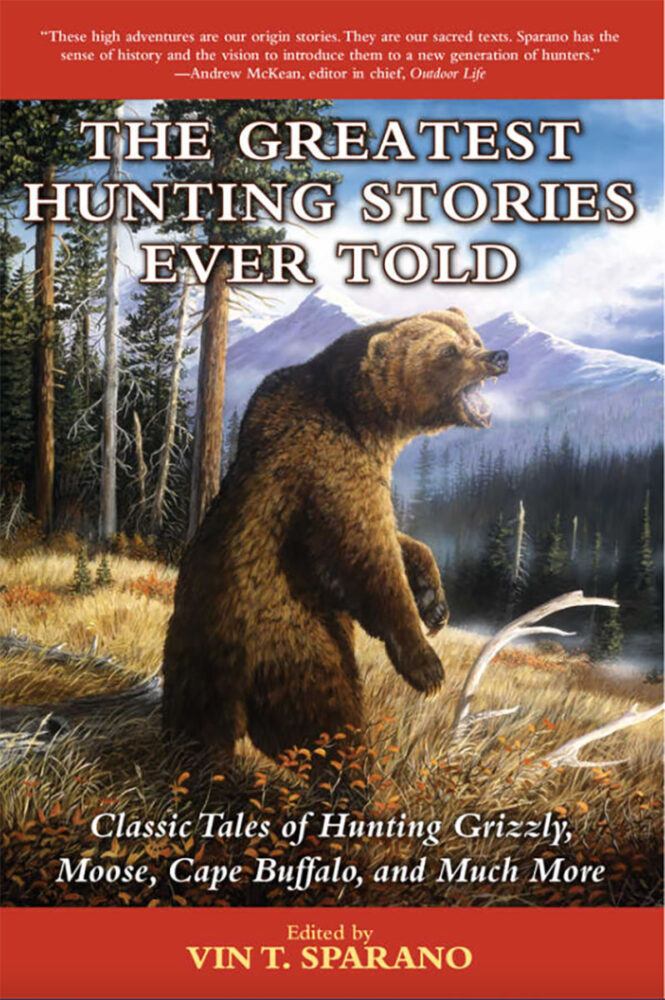 Now, for the forty million Americans who hunt, here is the perfect companion. The Greatest Hunting Stories Ever Told is a collection of true hunting tales, told by some of the most courageous and clever sportsmen. The quest for adventure has touched all these writers, who convey the drama, tension, stamina, and sheer thrill of tracking down game. Buy Now
Now, for the forty million Americans who hunt, here is the perfect companion. The Greatest Hunting Stories Ever Told is a collection of true hunting tales, told by some of the most courageous and clever sportsmen. The quest for adventure has touched all these writers, who convey the drama, tension, stamina, and sheer thrill of tracking down game. Buy Now

